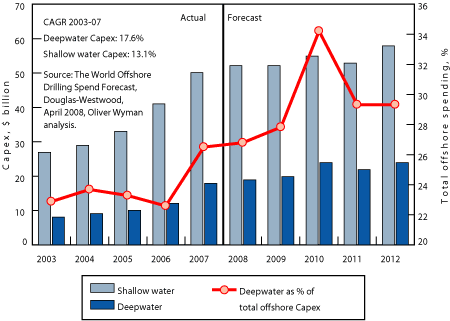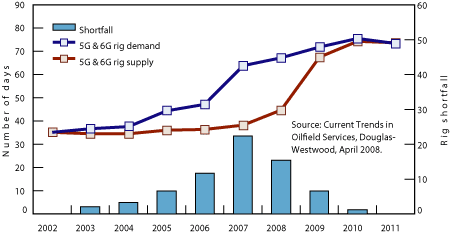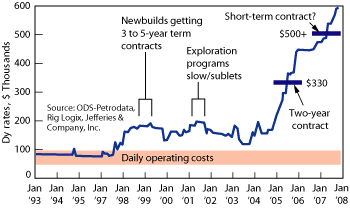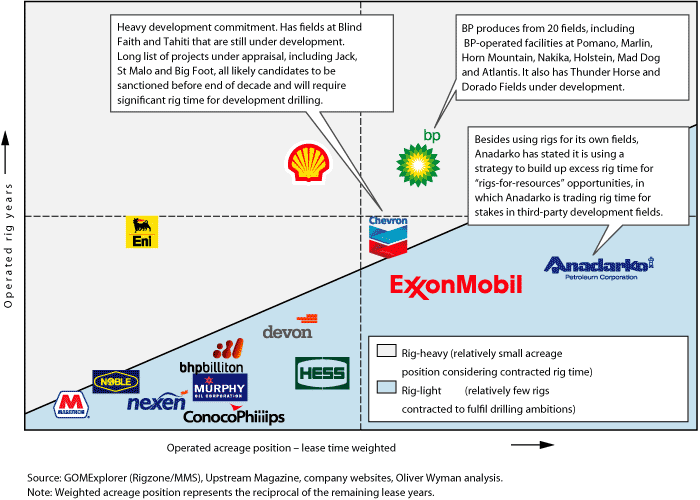As oil prices collapse and money becomes tighter, drilling programs may be at risk over the near term. However, due to a potential shortage of deepwater rig capacity, E&P companies must move now to develop a clear process of defining alternatives and evaluating financial and tactical tradeoffs.
Ryan Isherwood, Oliver Wyman; and Chris Reinsvold, Decision Strategies
Earning a good return on investment from deepwater developments has never been easy, given the enormous costs associated with finding and producing oil and gas from water depths measured in thousands of feet. Sky-high commodity prices obviously changed the calculus of deepwater development. Deepwater projects are projected to increase by 18% in the next five years, Fig. 1.
 |
|
Fig. 1. Record expenditures for offshore drilling.
|
|
But just as prices are now collapsing, a major obstacle could remain: If current predictions hold true, a severe shortage of sophisticated drilling equipment will soon cool the deepwater market - and force every E&P company with deepwater programs to factor these shortages into their long-range planning.
E&P companies are no strangers to cyclical shortages, of course, and their management teams know from experience that markets typically respond to shortfalls by generating new sources of supply. But deepwater drilling rigs bear little resemblance to their onshore cousins, and the tools required for ultra-deepwater development are among the most complex found in any industry.
The minimal number of new rigs expected to reach the market in the next three to four years will do little to alleviate the current situation before 2012, since more than 75% of these additions are already earmarked for immediate deployment, Fig. 2.
 |
|
Fig. 2. Projected deepwater rig shortage.
|
|
| |
As a result, with deepwater fleet utilization approaching 100%, dayrates of several hundred thousand dollars or more became the norm (Fig. 3) and a shortage of resources could continue into the next decade. As a result, companies that fail to “lock in” critical equipment may find themselves locked out of new deepwater opportunities.
 |
|
Fig. 3. Average ultra-deepwater day rates, 1993−2008.
|
|
| |
RIG MARKET COMPLEXITY
The current rig market adds complexity to the investment decisions that E&P companies must make on deepwater development. Both drillers and producers face unique challenges in the current deepwater dilemma. Drillers are finding themselves hamstrung by:
- Limited rig fleet with appropriate technology
- High cost of newbuilds
- Opportunity cost of not having available rigs
- Reluctance of producers to commit to long contracts
- Lack of adequate shipyard capacity
- Boom and bust industry cycles.
Producers meanwhile are beset by a different set of issues, including:
- Limited rig, platform supply vessel and FPSO availability
- High day rates
- Delayed development and exploration programs
- Expiring leases
- Impediments to bidding on new leases
- Long lead times.
This is not the first time that E&P companies have faced a dilemma in deepwater development. Rig availability tightened in the 1990s, and many of the solutions that were pursued during that era are once again being considered - such as E&P companies moving to own deepwater drilling rigs rather than merely renting them. The simple economics of such a decision are that at the leading edge of $500,000 day rates, for example, a company could purchase a $700 million drillship with daily operating costs of $100,000 and recoup the total investment in less than four years.
Proper due diligence, as always, should confirm the status of the drivers that influence supply and demand of rigs and the resulting utilization of the fleet that drives rig day rates. Developing a clear view on these drivers requires understanding the factors that influence each of them. For instance, getting a handle on the supply of newbuilds requires an understanding of shipyard availability, rig designers and engineers, equipment delivery constraints, etc. A thorough assessment of exploration drilling demand requires an understanding of the effects of expiring leases, production sharing agreements and more. Altogether, it can be a significant challenge to understand the net effect of these many interlocking factors.
RIG OWNERSHIP: WHAT IS THE RIGHT STRATEGY?
So, should E&P companies own their own rigs? The question is not whether these companies can afford to own rigs; clearly, they can. The better question is whether such a move is in the best interests of the company and its stakeholders.
The Return On Invested Capital (ROIC) minus the Weighted Average Cost of Capital (WACC) is the economic spread. After calculating the economic spread, deepwater development groups at Petrobras, Shell, ONCG and CNOOC decided to make substantial equity investments in deepwater rigs. In every instance, these equity positions involved large amounts of cash - but the companies evidently believe the rewards outweigh the risks. Their reasoning is simple: By making a large investment today, they guarantee their deepwater programs will have access to the rigs they need. Moreover, recent market value gains posted by deepwater drilling contractors such as Diamond Offshore, Transocean, Atwood and others have outpaced (and even doubled or tripled) the value gains recorded by the major oil and gas companies.
There is a downside risk to rig ownership, however, which extends beyond the amount of capital being invested. A decade ago, several multinational E&P companies that experimented with rig ownership found themselves after a few years in a market with flat or declining day rates and less-than-robust levels of fleet utilization. Over time, virtually all of these companies concluded that owning a deepwater drilling rig was not economically viable in the long term.
With this as a background, significantly fewer ownership deals have been struck this time around. In light of the current price collapse environment, those companies that held back because of fear of a softer market or a commodity price plummet may feel vindicated at the moment.
Other factors that may forestall these types of oil company collaborations include:
- Compared to a decade ago, there is much more “spot market” activity in deepwater rig chartering, which may be mitigating the short-term panic among E&P companies about the future availability of rigs.
- Contract drillers are flush with cash and can afford to pick and choose their strategic partners.
- E&P companies are more willing to enter into long-term agreements with rig contractors, which can then “bank” these commitments to finance new construction at favorable rates.
- Oil and gas companies did not fare well in the last round of “rig ownership deals” of the 1990s - and neither did the rig contractors.
- In the post-Enron era, companies are less inclined to pursue deals away from the balance sheet that could be criticized as “creative financing.”
A ROADMAP FOR DEEPWATER DEVELOPMENT
There are several possible solutions beyond the extremes of outright ownership of rig assets and relying on the spot market. These include, for example, sale/leaseback arrangements between a financial party and an E&P company, with an agreement for a rig contractor to operate the rig, as well as longer-term chartering with indexed dayrates.
Whichever choice an E&P company makes, it is consciously (or unconsciously, as the authors have found in several cases) making a bet on where the deepwater rig market is headed - and the economic implications of getting this bet right are enormous.
Determining which option makes the most sense will vary from company to company. Some E&P companies are long on attractive prospects and properties - and short on rig time. Others, on the other hand, appear to have more rig time than their drilling program needs imply, but long-term contracts at highly inflated prices leave them vulnerable to even a mild decline in oil prices, Fig. 4.
 |
|
Fig. 4. Operator exposure in Gulf of Mexico deep water.
Click Image to Enlarge.
|
|
| |
Identifing the best options for avoiding a rig shortage - or the risk of paying sky-high rates for available capacity - requires a clear process of defining alternatives and evaluating financial and tactical tradeoffs. The authors’ companies, for example, have used a five-point approach with E&P clients as a roadmap for developing the assets needed to deliver on a deepwater drilling program. Briefly, the steps in this program include:
1. Overall strategy and opportunity screening. The first step is to develop an accurate understanding of the current situation, in terms of existing rig availability, dayrate volatility and the overall deepwater strategy and objectives (e.g., minimizing drilling costs versus maximizing NPV). Potential opportunities to secure rigs at appropriate rates are initially screened against these goals.
2. Framing alternatives. Alternatives for securing capacity to meet drilling program goals are framed through input from key stakeholders and experts (e.g., drilling department manager, strategic planning department, corporate treasury, external industry experts). Key decision points are also developed along three lines: policy (such as whether the company will borrow funds to execute the drilling program), strategic (such as whether the company is willing to consider purchasing an equity interest in a rig) and tactical (decisions to be made later, such as the timing for when a well will be drilled).
3. Modeling and sensitivity analysis. Quantitative modeling is used to compare the expected values and upside/downside of identified alternatives. Information continues to be gathered from experts in each area to develop critical insights and test sensitivities. As an example, if a key objective is the expected NPV of a drilling program, some of the insights might include the effect of financing mechanisms and shipyard capacity on day rates. An important outcome from this phase is a properly defined set of uncertainties that might impact the adopted strategic approach.
4. Analysis of selected alternatives. A strategy is selected that appears to best meet the company’s objectives and refined through an examination of 1) the value of fnformation, to determine how much value can be gained by further analysis of uncertainties, and 2) the value of control, to help the company understand how much to pay for controlling a future outcome. An example of this might include buying an option for a rig to be delivered in the future. The selected alternative is validated against program objectives and key decision points, and contingency plans are created to mitigate the risks associated with the selected strategy.
5. Implementation and monitoring the strategy. The final phase of this process is the creation of the tactical plan to implement the strategy. This should include a resource plan, communication strategy and tracking metrics to be most effective.
Such a process can be instrumental in aligning rig supply with actual demand in a manner that makes economic and operational sense. With some producers spending more than half a billion dollars a year on their deepwater fleets and demand for such equipment scaling rapidly, it is clearly critical to get decisions about rig capacity commitments right the first time - and right now. 
|
THE AUTHORS
|
|
|
Ryan Isherwood is an Associate Partner in the Oil and Gas practice of Oliver Wyman, part of Marsh & McLennan Companies. He is based out of the Houston office. Prior to joining Oliver Wyman, Isherwood held positions at Jefferies Energy Consulting, Unocal and British-Borneo Oil and Gas, where he held senior-level executive positions in corporate development, strategic planning and operations. Mr. Isherwood earned a BS in mechanical engineering from the University of Washington and an MBA from the University of California, Berkeley.
|
|
|
|
Chris Reinsvold is Managing Director and Chief Strategy Officer at Decision Strategies. He has over 27 years of experience in the oil and gas industry working with Shell, CERA, IHS, Baker Hughes, Smith International and A.T. Kearney. He earned a bachelor’s degree in mechanical engineering from the California State Polytechnic University, Pomona, and an MBA from the University of Texas at Austin.
|
|
|








